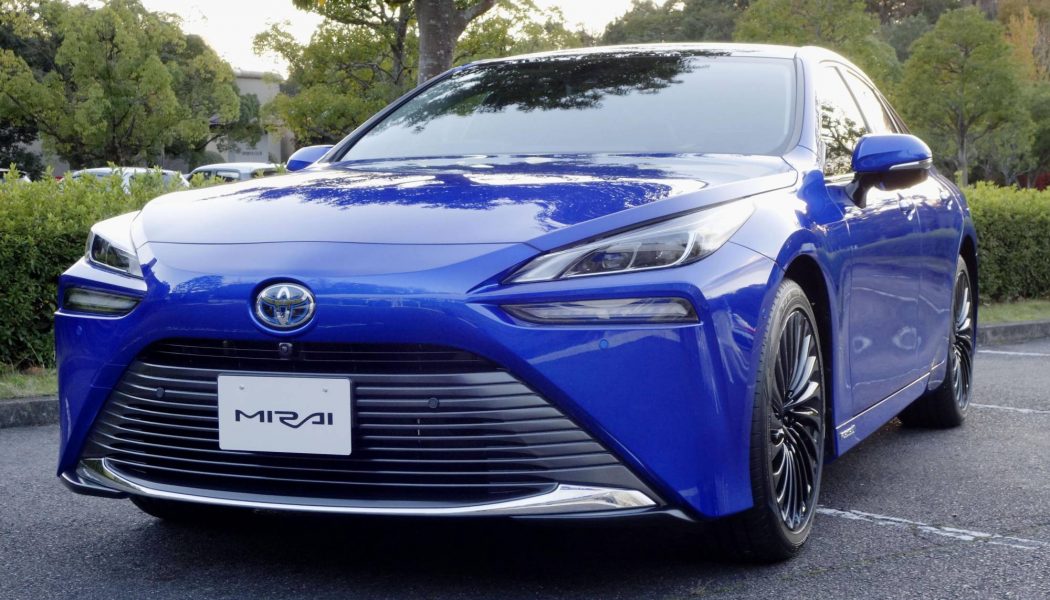While some of the MotorTrend staffers were busy putting the hydrogen fuel cell-powered 2021 Toyota Mirai through its paces at the test track, we used a second Mirai XLE as our daily driver, commuting around town and taking a short (socially-distanced) road trip. In this lower-key time spent behind the Mirai’s wheel, we learned a lot about the all-new fuel-cell vehicle, some of it good, some of it not so great. These are our key findings:
The 2021 Toyota Mirai could have been the Lexus Mirai
The first thing that struck us is just how nice a car the Mirai is. Obviously, the exterior styling is a huge improvement over the 2016-2020 Mirai (and let’s face it, visually speaking there was nowhere to go but up), but we can’t help but notice the clear Lexus vibe, and not just because of the Mirai’s vaguely-Lexus-LS-like profile. Despite the fact that we were driving the lesser XLE model, the cabin design and soft faux-leather seats felt more Lexus than Toyota to us, as did the ultra-quiet, baby-butt-smooth ride. Of course, the Mirai isn’t actually a Lexus, which means we didn’t have to put up with the hyper-annoying mouse-pad infotainment system, something that made us nearly happy enough to forgive the lack of a physical volume knob.
It’s a lot quieter than the old Mirai
Quiet is a relative term when one is talking about a car with electric drive. Like a nuclear submarine, the Mirai keeps its propulsion noises to a minimum, but the old Mirai emitted a seemingly random series of clicks, buzzes and whirs from the hydrogen fuel system. No more—aside from a little sigh as you shut it down, Toyota has managed to quell most of the pump and valve noises, and the 2021 Mirai doesn’t make much more noise than a typically silent battery-powered electric car.
The 2021 Toyota Mirai’s performance is … average
We timed the 2021 Toyota Mirai to 60 mph in 7.4 seconds, nearly two seconds quicker than Toyota’s own 9.2-second estimate. Power is moderate: The electric motor has 221 lb-ft of torque to motivate 4,243 pounds of Mirai, and it delivers that power judiciously so as not to waste too much hydrogen (more on which in a second). Off-the-line acceleration is handled by the battery alone, and that holds back that initial sprint. Like most EVs, the Mirai packs a strong mid-range but trails off at higher speeds.
The Toyota Mirai is better in the curves than we expected
The new Mirai is a proper rear-wheel-drive vehicle, with its 182-hp electric motor connected to the rear axle. Toyota touts it as “a premium rear-wheel drive sports-luxury FCEV” (try saying that ten times fast when you’re drunk—or even sober), but of course, we’re using Toyota’s definition of sporty. We took the Mirai on a couple of our favorite curvy roads, and if driven deliberately rather than aggressively, it comes across as surprisingly competent and—dare we say it?—almost enjoyable. There isn’t enough power for tire-smoking tail-out action, but driven rapidly the Mirai feels thoroughly competent, and that’s a rare sensation in a green-themed Toyota.
… but driving it fast will cost you
The problem with making rapid curvy-road progress in the 2021 Toyota Mirai is that consumes hydrogen as if it were the most common element in the Universe. Which it is, but not necessarily in forms that can be readily delivered to the Mirai’s three-section fuel tank. Mirai fuel economy is measured in MPGe—Miles Per Gallon Equivalent—and the EPA gives it a 74 MPGe combined rating, but driving rapidly dropped our numbers down into the low 40s (and, on the steepest hills, down into the 20s), which has a tragic effect on range. You can hustle the Mirai, but it dramatically shortens your tether.
The Toyota Mirai is at its best in Los Angeles traffic
The 2021 Toyota Mirai is, at its heart, a hybrid car. There’s a small 1.24 kWh battery—a tad more capacity than the one in the Prius hybrid—which acts as a buffer of sorts. The battery gets the Mirai rolling from rest before the fuel cell stack starts up, then assists with acceleration as needed and acting as sole power when cruising at steady speeds. As with a hybrid or an EV, the battery charges as the car decelerates, and it can get juice from the fuel cell stack as needed. We expected slow stop-and-go traffic to be where the Mirai returned its best fuel economy, but our in-town MPGe hovered around 70, below the XLE’s 76 MPGe estimate.
It was on LA’s viscous freeway traffic that the Mirai did its best. If we picked our lane carefully and kept up a steady 30 or so, where the battery could keep those low-rolling-resistance tires turning without hydrogen help, our average MPGe crept up into the low 80s. It’s as if the car was designed for California traffic … but of course, California is the only state where you can get a Mirai, or enjoy remotely convenient access to hydrogen fuel.
402 miles of range? Maybe not.
Toyota is touting a 402 mile range for the Mirai XLE, while the Mirai Limited is rated at 357 due to around 80 lbs more weight and a more aggressive tire. Which is neither here nor there, because the Mirai’s own range-o-meter never showed us with more than 262 miles being available. Granted, we did some lead-footing, as is our job, but we also did our share of eco-cruising. It’s possible the average was slow to update; if we were able to maintain even a 70 MPGe average, the Mirai should manage close to 400 miles. Still, we kept a careful eye on that distance-to-empty age. “Range anxiety” is generally a non-issue when there’s electricity waiting at home, but with the hydrogen fueling infrastructure still in its infancy, range is much more important.
The Mirai could get really expensive when and if you have to pay for the fuel.
Hydrogen is expensive: We paid $16.70 per kilogram, and the Mirai’s tank holds 5.6 kg. For those of you not mathematically inclined, that’s a $93.52 fill-up if your Mirai is running on fumes. (Bad choice of words, perhaps. Since hydrogen is gaseous, one could say the Mirai always runs on fumes.) From three-quarters of a tank, we paid nearly $75 to fill up. This won’t be an issue right away, as the Mirai comes with $15,000 or 3 years’ worth of free hydrogen. That’s enough for 160 complete fills, and even if the Mirai were to only manage 250 miles per tank, would take you to around 37,500 miles. Hydrogen prices are expected to drop to $6-7/kg by 2024 or 2025, but if that doesn’t happen, your 2021 Toyota Mirai could start to feel an awful lot like a 1974 Plymouth Fury.










